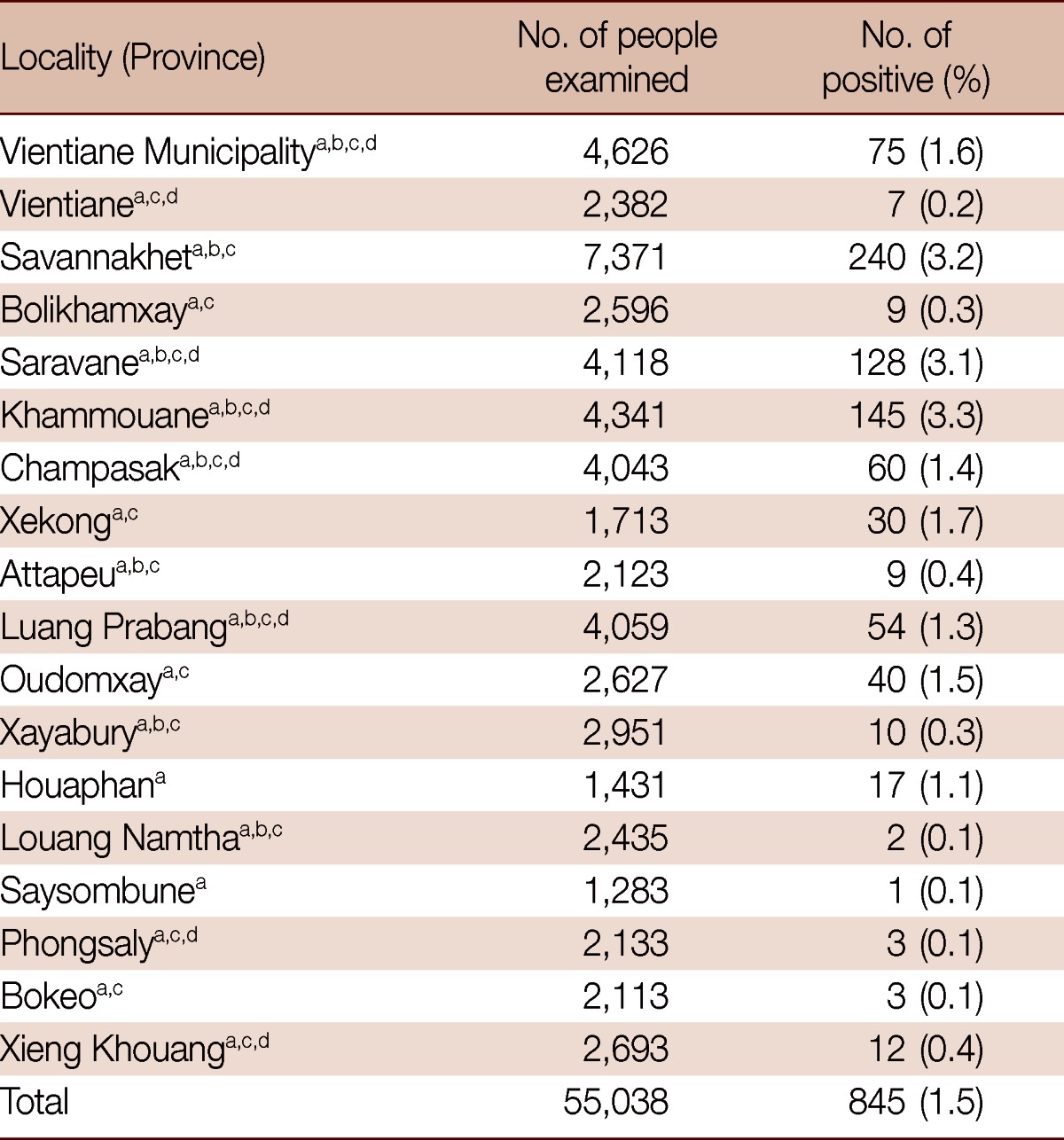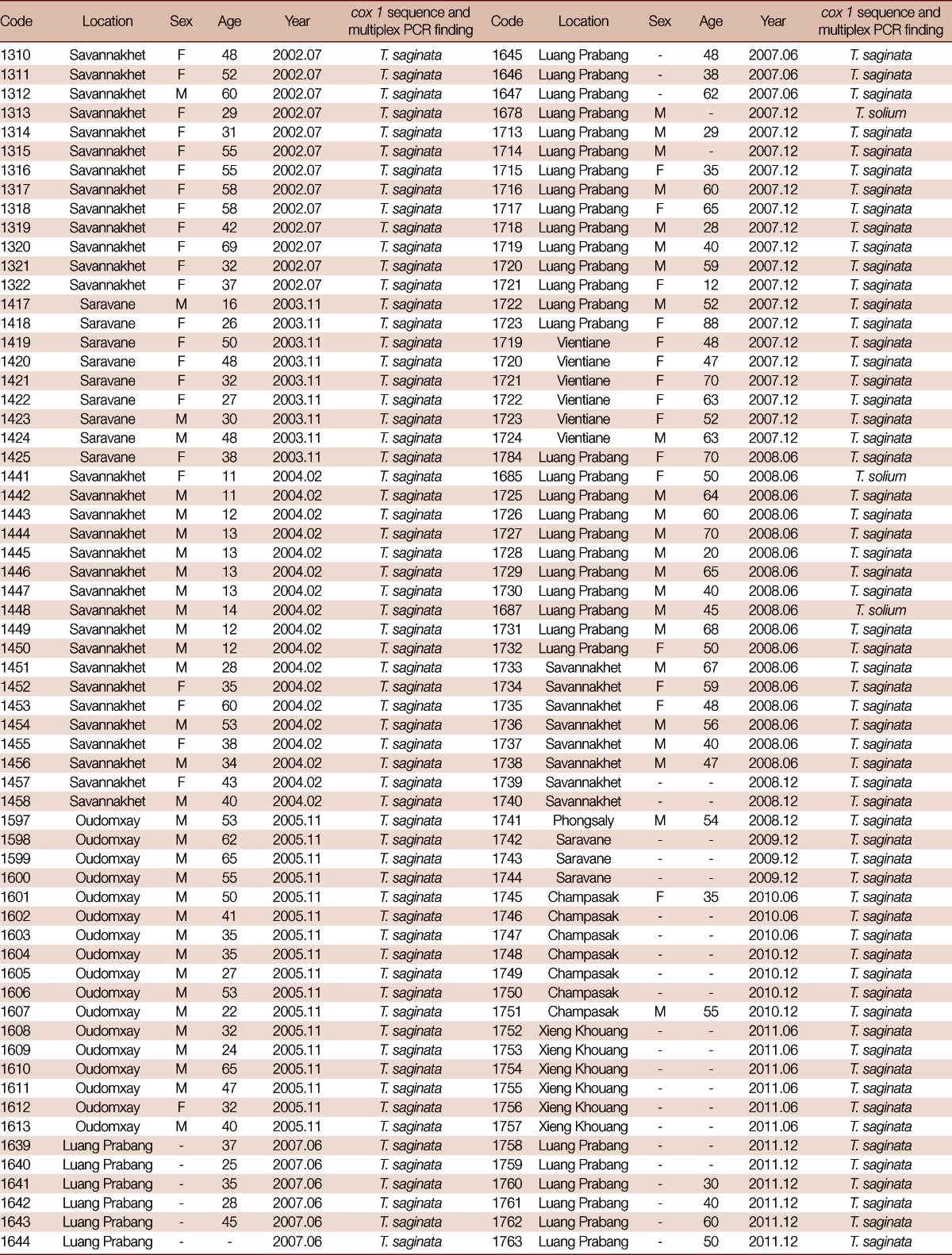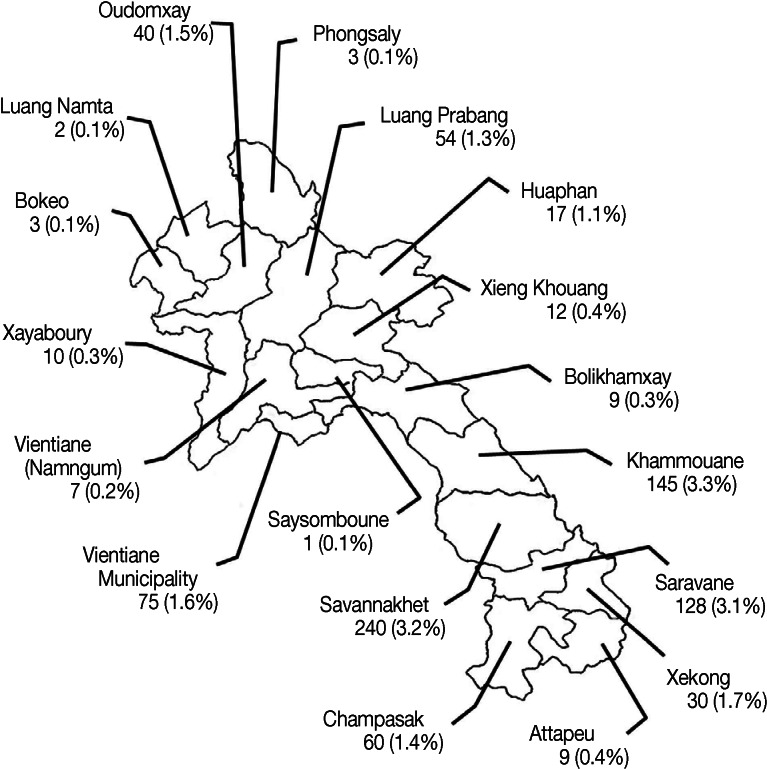Abstract
Human taeniasis was investigated in Lao People's Democratic Republic (Lao PDR) between 2000 and 2011 as part of the nation's helminthiasis survey. A total of 55,038 inhabitants, including 29,846 school children, were examined using the Kato-Katz and scotch-tape anal swab method, and morphological observation of adult worms. Molecular identification of Taenia tapeworms was performed by multiplex PCR or DNA sequence analysis of the mitochondrial cox1 gene. Taenia eggs were present at a rate of 1.5% (845/55,038) in the subject population. Adult tapeworms were identified as T. solium or T. saginata by analyzing the collectable stool specimens (n=126). Three specimens identified as T. solium were found in Luang Prabang, while the remaining 123 specimens, which were T. saginata, were found in Bokeo, Bolikhamxay, Champasak, Houaphan, Khammouane, Luang Namta, Luang Prabang, Oudomxay, Phongsaly, Saysomboune, Saravane, Savannakhet, Xayaboury, Xekong, Xieng Khouang Province, and Vientiane Municipality.
Keywords: Taenia saginata, Taenia solium, human taeniasis, Lao PDR
Taenia solium, T. saginata, and T. asiatica are taeniid tapeworms that cause taeniasis in humans and cysticercosis in intermediate host animals. Taeniasis and cysticercosis remain a significant public health problem in regions of Asia, Africa, Eastern Europe, and Central and South America. Information on the distribution and prevalence of taeniasis and cysticercosis in Indochina (Cambodia, Lao PDR, and Vietnam) is rather limited when compared to that for endemic regions of Latin America and Africa.
Prevalence data on taeniasis indicated that T. solium is more common than T. saginata in Lao PDR [1]. Studies on human taeniases in Lao PDR have been carried out in Vientiane, Khammouane, and Champasak Province between 1989 and 2002 [2-5]. In addition, a nationwide survey was conducted between 2000 and 2002 using cellophane anal swab and the Kato-Katz method [6]. In 2004, a total of 814 subjects from 13 villages in Saravane Province were investigated, and the overall prevalence of taeniasis in the population was shown to be 5% [7]. These data were confirmed by coprological egg examination or morphological observations of the expelled proglottids. However, for Lao PDR, so far very little information is available on differential Taenia species identification despite having conducted surveys.
Epidemiologically, all 3 Taenia tapeworms that infect humans have been found in Asian countries, including China, Indonesia, Korea, the Philippines, Taiwan, Thailand, Vietnam, and Japan [8]. However, the epidemiological distribution status of these tapeworms still needs to be clarified in Lao PDR.
International collaboration projects between Korea and Lao PDR have been ongoing since 2000. These 11-year nationwide surveys on 17 provinces and Vientiane Municipality involved stool examination using the Kato-Katz and scotch-tape anal swab method. The aim of these projects was to eliminate helminth infections and promote health by controlling these infections and appropriately treating them. The present study focused on identification of Taenia cases in Lao PDR by microscopic examinations for the presence of eggs in stool, morphological observation of adult tapeworms, multiplex PCR, and nucleotide analysis for sequence variation.
A total of 55,038 fecal specimens were collected between 2000 and 2011 from 17 provinces of Lao PDR, including 176 districts of 18 regions. A nationwide survey on 29,846 children aged 6-11 years, from 317 primary schools, was conducted between 2000 and 2002. The remaining fecal specimens (n=25,192) were collected from schoolchildren and residents between 2002 and 2011. The Vientiane Municipality (n=599), Savannakhet (n=981), Champasak (n=620), Attapeu (n=763), Luang Prabang (n=589) and Xayaboury (n=558) were surveyed in 2002; Khammouane (n=1,242) and Saravane (n=1,270) were surveyed in 2003; and Vientiane Municipality (n=185), Luang Namta (n=198), and Savannakhet (n=248) were surveyed in 2005. A nationwide survey on 11,770 schoolchildren aged 6-11 years was also conducted in 2005. The Vientiane Municipality (n=527) was surveyed in December, 2007; Savannakhet and Phongsaly Province (n=11,115) in July and December, 2008; Khammouane Province (n=5,247) was surveyed in June, 2009; Saravane Province (n=4,586) was surveyed in December, 2009; Champasak Province (n=669) was surveyed in June, 2010; Champasak Province and Vientiane Municipality (n=426) were surveyed in December, 2010; Xieng Khouang (n=642) was surveyed in June, 2011; and Luang Prabang (n=557) was surveyed in December, 2011 (Table 1).
Table 1.
Prevalence of taeniasis in 17 provinces and the Vientiane Municipality, Lao PDR (2000.2011)

Fecal examination was performed by the Kato-Katz method.
a2000-2002: School children (n=29,846); b2002-2004: Inhabitants of 16 Provinces over 15 years of age (n=7,244); c2005: Nationwide survey on school children aged 6-11 years (n=11,770); d2007-2011: Inhabitants of 7 Provinces over 15 years of age (n=6,178).
Fecal specimens were examined for intestinal helminth eggs using the Kato-Katz thick smear technique. A total of 126 Taenia tapeworms were recovered from patients who were positive for intestinal helminth eggs. Patients discharged the adult tapeworms after treatment with a single oral dose of 20-30 mg praziquantel (Shinpoong Pharm. Co., Seoul, Korea) followed by purgation with magnesium salts. The worms were fixed in 10% formalin under slide glass pressure and then acetocarmine-stained for morphological identification using a light microscope. Some worms were fixed in 70% ethanol for genetic identification by DNA sequencing.
The purified PCR-amplified fragments of the cox1 gene were directly sequenced. The primer walking method was employed to obtain direct sequences for each of the amplified fragments. Cyclic sequencing from both ends of the fragments was performed using a Big-Dye Terminator sequencing kit (Applied Biosystems, Foster City, California, USA) and the reaction products were electrophoresed on an automated DNA sequencer (model 3730KL, Applied Biosystems). The sequences were assembled and aligned using the Bioedit program version 5.0.6 (BIOSOFT, Ferguson, Missouri, USA). Using BLAST searches, the sequenced regions were identified by comparing them with those of Taenia tapeworms, which had been deposited in the GenBank database. We identified Taenia tapeworm specimens by comparing the nucleotide sequences obtained with those of the cox1 genes of T. solium (GenBank no. AB086256), T. saginata (Genbank no. AY684274), and T. asiatica (GenBank no. AF445798). Multiplex PCR was performed on all specimens as described previously [9].
The tapeworm specimens (n=126) collected were analyzed by observing their morphological features and nucleotide sequences of the mitochondrial cox1 gene. Adult tapeworms and metacestodes were examined morphologically after carmine staining. Genomic DNA of the specimens was extracted with the DNeasy Tissue Kit (Qiagen, Valencia, California, USA). The PCR amplification products were directly sequenced using the Big-Dye Terminator Cycle Sequencing Kit (Applied Biosystems).
A total of 55,038 inhabitants, including 29,846 schoolchildren, were examined by coprological microscopy between 2000 and 2011. The prevalence of Taenia eggs was 1.5% (845/55,038) (Table 1). A total of 126 adult tapeworms were collected in Savannakhet, Saravane, Oudomxay, Luang Prabang, Champasak, Xieng Khouang, and Vientiane. Other isolated helminth eggs included Ascaris lumbricoides, hookworms, Trichuris trichiura, Trichostrongylus orientalis, Opisthorchis viverrini/minute intestinal flukes, and Echinostoma spp. A slightly higher prevalence of human taeniasis (3.1% and 3.3%) was observed in Savannakhet, Saravane, and Khammouane, respectively. In the remaining provinces, the prevalence of taeniasis was 0.7% on average (Fig. 1), with the highest (3.3%) in Khammouane.
Fig. 1.
Surveyed provinces and districts in Lao PDR.
Molecular identification of Taenia tapeworms was performed by multiplex PCR and DNA sequence analysis, corresponding to positions 90-530 of the cox1 gene. The cox1 sequences (440 bp) with code numbers 1678, 1685, and 1687 showed 99.7% similarity with the reference sequence of T. solium (GenBank no. AB086256), and the remaining samples showed 99.3% similarity with T. saginata (GenBank no. AY684274). Multiplex PCR revealed a 474 bp diagnostic band in the T. solium samples with code numbers 1678, 1685, and 1687. The remaining 123 specimens were identified by DNA sequencing of the cox1 gene and multiplex PCR, revealing a 629 bp diagnostic band specific to T. saginata (Table 2). The Taenia tapeworms isolated from Lao PDR were T. solium and T. saginata. Three T. solium specimens were found in Luang Prabang, and 123 T. saginata specimens were found in other provinces (Table 2).
Table 2.
Taenia tapeworm specimens of Laotians analyzed in the present study (2002-2011)

Numerous surveys on intestinal parasite infections have been conducted in Lao PDR over the past 20 years, including 9 published papers. However, information on taeniasis and cysticercosis from community-based surveys in Lao PDR is rather limited when compared to information from endemic regions in other Asian countries and Latin America. The present study was carried out between 2000 and 2011 on a total of 55,038 fecal specimens, including 126 adult tapeworms collected from 176 districts in 18 regions including 17 provinces of Lao PDR. The prevalence of human taeniasis ranged from 0.1% to 3.3%. Central regions such as Saravane, Savannakhet, and Khammouane showed higher prevalence of human taeniasis. A previous nationwide survey of human taeniasis among primary schoolchildren observed a 0.6% incidence [6]. Another study on human taeniasis indicated that all 3 species infecting humans were present in Lao PDR [10]. Further studies are required to confirm this. In addition, previous studies have shown that T. solium is more common than T. saginata in this area [1]. This is in disagreement with our results, which show that T. saginata is more common than T. solium. One of the sources of infection for T. saginata is believed to be "lap", a Laotian dish made of raw cow's liver, commonly consumed in these communities. Risk factors for T. solium taeniasis and cysticercosis infection in Lao PDR may come from consuming raw pork such as "sommou" and using human feces to fertilize vegetable gardens. The habit of eating raw pork is quite common in northern highlands in Vietnam [11] and also in Lao PDR.
Previously, clear reports on T. solium adult tapeworms were almost not available. In the present study, through morphological and genetic analysis, we identified 3 specimens of T. solium out of 126 collected worms. The T. solium infections observed came from inhabitants of the Lathahea district, Luang Prabang, which is located in the northern part of Lao PDR. In addition, a male patient from Oudomxay, a province near our survey region, was diagnosed with neurocysticercosis in 2005. He had been previously diagnosed by CT scan in Thailand, following an epileptic seizure in 1993. In 2007, a pig with a heavy T. solium metacestode infection was discovered in a slaughterhouse in Oudomxay (unpublished observation).
All 3 species of human Taenia tapeworms, T. solium, T. saginata, and T. asiatica have been found in countries near Lao PDR, like Vietnam, Thailand, and Yunnan Province of China [12]. T. asiatica has been found in many Asian countries, such as Korea, China, Indonesia, the Philippines, Vietnam, Thailand, and Japan; however, its distribution in Lao PDR still needs to be clarified. Recently, molecular diagnostic methods have been developed for the rapid and accurate detection of tapeworm infections, including the use of formalin-fixed or sectioned and stained specimens. If more molecular diagnostic methods are applied to field surveys, it would be possible to obtain more precise epidemiological data on tapeworm infections in Lao PDR.
ACKNOWLEDGMENTS
We thank the staff of the Center for Laboratory and Epidemiology, Department of Hygiene and Prevention, Vientiane, and Provincial Health Department, Lao PDR for their effort in collecting fecal samples and preparing Kato-Katz smears. The Korea Association of Health Promotion (KAHP) and the Korea International Cooperation Agency (KOICA) have supported intestinal parasite control programs among primary schoolchildren in Lao PDR (2000-2004). The Korean Foundation for International Healthcare (KOFIH), KOICA, and the Ministry of Healthcare of the Lao PDR have backed up a collaborative project between Korea and Lao PDR to control food-borne trematode infections in Laos (2007-2012). This work was supported by a research grant from Chungbuk National University in 2012 for DNA analysis, data processing, and statistical analysis. Some parasite materials used in this study were provided by the Parasite Resource Bank of Korea, National Research Center (2012-0000037), Republic of Korea.
References
- 1.Le Francois. Recherches de Parasitologie comparée Indochinoise. Paris, France: 1938. pp. 107–111. [Google Scholar]
- 2.Kobayashi J, Vannachone B, Xeutvongsa A, Manivang K, Ogawa S, Sato Y, Pholsena K. Prevalence of intestinal parasitic infection among children in two villages in Lao PDR. Southeast Asian J Trop Med Public Health. 1996;27:562–565. [PubMed] [Google Scholar]
- 3.Chai JY, Hongvanthong B. A small-scale survey of intestinal helminthic infections among the residents near Parkse, Laos. Korean J Parasitol. 1998;36:55–58. doi: 10.3347/kjp.1998.36.1.55. [DOI] [PubMed] [Google Scholar]
- 4.Hohmann H, Panzer S, Phimpachan C, Southivong C, Schelp PF. Relationship of intestinal parasites to the environment and to behavioral factors in children in the Bolikhamxay province of Lao PDR. Southeast Asian J Trop Med Public Health. 2001;32:4–13. [PubMed] [Google Scholar]
- 5.Vannachone B, Kobayashi J, Nambany S, Manivong K, Inthakone S, Sato Y. Epidemiological survey on intestinal parasite infection in Khammouane province, Lao PDR, with special reference to Strongyloides infection. Southeast Asian J Trop Med Public Health. 1998;29:717–722. [PubMed] [Google Scholar]
- 6.Rim HJ, Chai JY, Min DY, Cho SY, Eom KS, Hong SJ, Sohn WM, Yong TS, Standgaard GDH, Phommasack B, Yun CH, Hoang EH. Prevalence of intestinal parasite infections on a national scale among primary schoolchildren in Laos. Parasitol Res. 2003;91:267–272. doi: 10.1007/s00436-003-0963-x. [DOI] [PubMed] [Google Scholar]
- 7.Sayasone S, Odermatt P, Phoumindr N, Vongsaravane X, Sensombath V, Phetsouvavh R, Choulamany X, Strobel M. Epidemiology of Opisthorchis viverrini in a rural district of southern Lao PDR. Trans R Soc Trop Med Hyg. 2007;101:40–47. doi: 10.1016/j.trstmh.2006.02.018. [DOI] [PubMed] [Google Scholar]
- 8.Eom KS, Jeon HK, Rim HJ. Geographical distribution of Taenia asiatica and related species. Korean J Parasitol. 2009;47(suppl):S115–S124. doi: 10.3347/kjp.2009.47.S.S115. [DOI] [PMC free article] [PubMed] [Google Scholar]
- 9.Jeon HK, Chai JY, Kong Y, Waikagul J, Insisiengmay B, Rim HJ, Eom KS. Differential diagnosis of Taenia asiatica using multiplex PCR. Exp Parasitol. 2009;121:151–156. doi: 10.1016/j.exppara.2008.10.014. [DOI] [PubMed] [Google Scholar]
- 10.Conlan J, Khounsy S, Inthavong P, Fenwick S, Blacksell S, Thompson RCA. A review of taeniasis and cysticercosis in the Lao People's Democratic Republic. Parasitol Int. 2008;57:252–255. doi: 10.1016/j.parint.2008.04.002. [DOI] [PubMed] [Google Scholar]
- 11.Willingham AL, III, Van De N, Doanh NQ, Cong le D, Dung TV, Dorny P, Cam PD, Dalsgaard A. Current status of cysticercosis in Vietnam. Southeast Asian J Trop Med Public Health. 2003;34(Suppl 1):35–50. [PubMed] [Google Scholar]
- 12.Zhang L, Tao H, Zhang B, Wang H, Wang Y, Li Z, Yang B, Pang Y, Zhang H, Li Y, Wu Y. First discovery of Taenia saginata asiatica infection in Yunnan province. Zhongguo Ji Sheng Chong Xue Yu Ji Sheng Chong Bing Za Zhi. 1999;17:95–96. (in Chinese) [PubMed] [Google Scholar]



